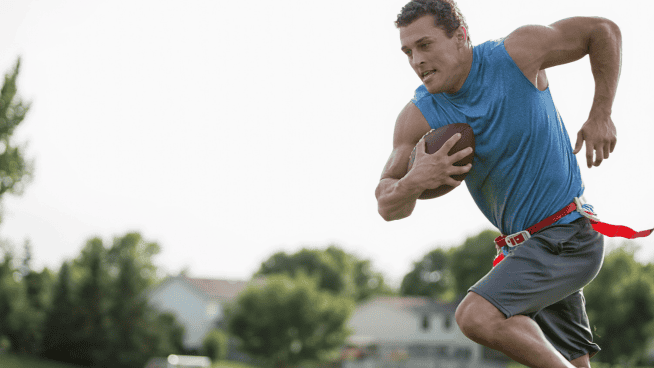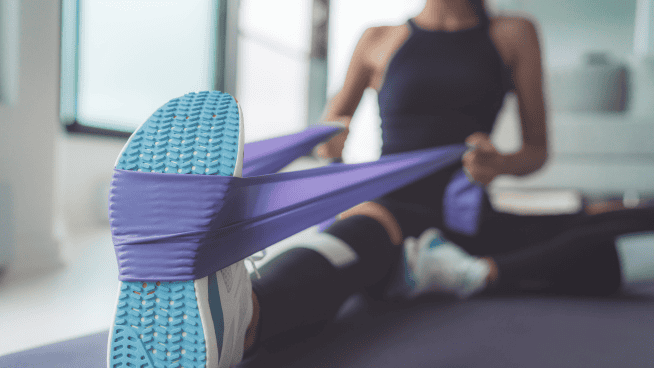Are You Strong Enough to Back Squat?
The Back Squat is one of the biggest bang-for-your buck strength training exercises out there. Squatting can increase muscle mass, strength, power and vertical jump height.
Unfortunately, not all athletes are prepared to Back Squat on Day 1. To safely progress to the Squat, you must go through a series of progressions that build off the previous exercise.
These exercises gradually require more mobility and stability to get into the correct positions, and the weight used increases as well.
Follow the progressions below and watch your Squat improve. Once you complete this series, continue to use the progressions as assistance exercises to keep building stability and refining your movement patterns.
RELATED: Elite Performance With Mike Boyle: Teach Any Athlete How to Squat Properly.
1. Half-Kneeling Chop
This exercise might look nothing like a Squat, but it trains many of the key components. The half-kneeling position requires good core stability and hip mobility. Done properly, it activates the glutes on the lower leg and stretches the quads and hip flexors. The abdominal muscles are also engaged to maintain a neutral spine. The cross-body nature of the chop challenges core stability in three directions, which positively transfers to squatting movements.
[youtube video=”bzKvQdWy5Vo” /]Directions
- Set up in the half-kneeling position with your front leg closest to the band or cable column and parallel to the floor. Your back leg should be in a straight line from your knee to your hip.
- Squeeze your bottom glute by tucking your pelvis under, and activate your abdominals by bringing your rib cage down.
- Once you are stable, grab the band or cable and chop from high to low across your body while maintaining a stable torso. The goal is to resist rotation in your lumbar spine as much as possible while allowing for thoracic rotation as you chop with your upper body.
Sets/Reps: 3 x 8-10 per side.
2. Goblet Split Squat
This exercise builds on the foundation built in the previous exercise, but now the stable half-kneeling position becomes a dynamic Split Squat. With your knee off the ground and moving, the need to create stability increases. A kettlebell or dumbbell is used in the “goblet” position to activate your abdominals and keep your chest upright.
[youtube video=”RUUqREYpeZY” /]Directions
- Assume the split squat position, similar to the half-kneeling position except your knee is not on the ground.
- Place a mat or plate under your knee to ensure depth.
- Grab a kettlebell or dumbbell and hug it to your chest.
- Activate your abdominals and squat down until your back knee hits the mat.
- Aim to find a 90/90 position at the bottom of your Split Squat, similar to the half-kneeling position.
- Rise back up and repeat.
Sets/Reps: 3 x 8-10 per side.
3. Double Kettlebell Front-Foot-Elevated Split Squat
Once again, this exercise requires more mobility and stability than the previous exercise. The block increases range of motion, which requires more stability and mobility. The double kettlebells increase core stability demands and allow more weight to be used.
[youtube video=”wdPS_JP7Tcc” /]Directions
- Start with your front foot on a 4-inch plate or block.
- Grab two kettlebells in the front rack position with the handles facing inward.
- Activate your core and squat down until your back knee touches the mat.
- Rise back up and repeat.
Sets/Reps: 3 x 6-8 per side.
4. Goblet Squat
With this exercise, you move from a split position to a truly bilateral position, which, although it may seem more stable, is actually more challenging. A strong core is necessary to prevent the pelvis from tipping forward, and stability created in the previous exercises comes into play. Once again, the kettlebell in the goblet position helps activate the core.
Directions
- Set up with your feet around shoulder-width apart and your feet in a comfortable position.
- Grab the kettlebell in the goblet position and hug it to your chest.
- Activate your core and squat down as low as possible while maintaining a neutral spine.
- Rise up and squeeze your glutes at the top to extend your hips.
Sets/Reps: 3 x 6-8 per side.
Try the Goblet Squat Challenge.
5. Double Kettlebell Front Squat
Double kettlebells allow you to use more weight to challenge your leg strength while also increasing your core stability. The kettlebells are higher, more closely simulating a front or back squat. This is the final kettlebell progression before moving on to a barbell.
Directions
- Set up with your feet around shoulder-width apart and in a comfortable position.
- Grab the kettlebells in the double rack position with the handles facing inward.
- Activate your core and squat down as low as possible while maintaining a neutral spine.
- Rise up and squeeze your glutes at the top to extend your hips.
Sets/Reps: 3 x 5-8
6. Front Squat
This is the first variation using a barbell instead of kettlebells. Many athletes don’t need to progress past the Front Squat for several reasons. The front rack position might be uncomfortable at first, but it will get better with practice. The Front Squat allows slightly less weight to be used than a Back Squat, but it challenges core stability more. In addition, it allows you to maintain a more upright torso, which takes stress off the spine.
[youtube video=”gUxjAV9A5ys” /]Directions
- Set up in the rack with the bar near shoulder height.
- Set the bar on your shoulders above your collarbone with your grip just outside shoulder-width and your elbows high and out.
- Walk two steps back, activate your core, and squat down as low as possible while keeping a neutral spine.
- Rise up and squeeze your glutes at the top to extend your hips.
Sets/Reps: 3 x 3-5
RELATED: Back Squat vs. Front Squat: What’s the Better Choice for Athletes
Once you can safely perform all these exercises, you are ready to progress to the Back Squat. These movements can then be used as assistance exercises in your strength training program to further improve stability and mobility even after you can back squat safely and effectively.
[cf]skyword_tracking_tag[/cf]RECOMMENDED FOR YOU
MOST POPULAR
Are You Strong Enough to Back Squat?
The Back Squat is one of the biggest bang-for-your buck strength training exercises out there. Squatting can increase muscle mass, strength, power and vertical jump height.
Unfortunately, not all athletes are prepared to Back Squat on Day 1. To safely progress to the Squat, you must go through a series of progressions that build off the previous exercise.
These exercises gradually require more mobility and stability to get into the correct positions, and the weight used increases as well.
Follow the progressions below and watch your Squat improve. Once you complete this series, continue to use the progressions as assistance exercises to keep building stability and refining your movement patterns.
RELATED: Elite Performance With Mike Boyle: Teach Any Athlete How to Squat Properly.
1. Half-Kneeling Chop
This exercise might look nothing like a Squat, but it trains many of the key components. The half-kneeling position requires good core stability and hip mobility. Done properly, it activates the glutes on the lower leg and stretches the quads and hip flexors. The abdominal muscles are also engaged to maintain a neutral spine. The cross-body nature of the chop challenges core stability in three directions, which positively transfers to squatting movements.
Directions
- Set up in the half-kneeling position with your front leg closest to the band or cable column and parallel to the floor. Your back leg should be in a straight line from your knee to your hip.
- Squeeze your bottom glute by tucking your pelvis under, and activate your abdominals by bringing your rib cage down.
- Once you are stable, grab the band or cable and chop from high to low across your body while maintaining a stable torso. The goal is to resist rotation in your lumbar spine as much as possible while allowing for thoracic rotation as you chop with your upper body.
Sets/Reps: 3 x 8-10 per side.
2. Goblet Split Squat
This exercise builds on the foundation built in the previous exercise, but now the stable half-kneeling position becomes a dynamic Split Squat. With your knee off the ground and moving, the need to create stability increases. A kettlebell or dumbbell is used in the “goblet” position to activate your abdominals and keep your chest upright.
[youtube video=”RUUqREYpeZY” /]Directions
- Assume the split squat position, similar to the half-kneeling position except your knee is not on the ground.
- Place a mat or plate under your knee to ensure depth.
- Grab a kettlebell or dumbbell and hug it to your chest.
- Activate your abdominals and squat down until your back knee hits the mat.
- Aim to find a 90/90 position at the bottom of your Split Squat, similar to the half-kneeling position.
- Rise back up and repeat.
Sets/Reps: 3 x 8-10 per side.
3. Double Kettlebell Front-Foot-Elevated Split Squat
Once again, this exercise requires more mobility and stability than the previous exercise. The block increases range of motion, which requires more stability and mobility. The double kettlebells increase core stability demands and allow more weight to be used.
[youtube video=”wdPS_JP7Tcc” /]Directions
- Start with your front foot on a 4-inch plate or block.
- Grab two kettlebells in the front rack position with the handles facing inward.
- Activate your core and squat down until your back knee touches the mat.
- Rise back up and repeat.
Sets/Reps: 3 x 6-8 per side.
4. Goblet Squat
With this exercise, you move from a split position to a truly bilateral position, which, although it may seem more stable, is actually more challenging. A strong core is necessary to prevent the pelvis from tipping forward, and stability created in the previous exercises comes into play. Once again, the kettlebell in the goblet position helps activate the core.
[youtube video=”dlQXwdFvMs0″ /]Directions
- Set up with your feet around shoulder-width apart and your feet in a comfortable position.
- Grab the kettlebell in the goblet position and hug it to your chest.
- Activate your core and squat down as low as possible while maintaining a neutral spine.
- Rise up and squeeze your glutes at the top to extend your hips.
Sets/Reps: 3 x 6-8 per side.
Try the Goblet Squat Challenge.
5. Double Kettlebell Front Squat
Double kettlebells allow you to use more weight to challenge your leg strength while also increasing your core stability. The kettlebells are higher, more closely simulating a front or back squat. This is the final kettlebell progression before moving on to a barbell.
[youtube video=”of9dLE4g_BQ” /]Directions
- Set up with your feet around shoulder-width apart and in a comfortable position.
- Grab the kettlebells in the double rack position with the handles facing inward.
- Activate your core and squat down as low as possible while maintaining a neutral spine.
- Rise up and squeeze your glutes at the top to extend your hips.
Sets/Reps: 3 x 5-8
6. Front Squat
This is the first variation using a barbell instead of kettlebells. Many athletes don’t need to progress past the Front Squat for several reasons. The front rack position might be uncomfortable at first, but it will get better with practice. The Front Squat allows slightly less weight to be used than a Back Squat, but it challenges core stability more. In addition, it allows you to maintain a more upright torso, which takes stress off the spine.
[youtube video=”gUxjAV9A5ys” /]Directions
- Set up in the rack with the bar near shoulder height.
- Set the bar on your shoulders above your collarbone with your grip just outside shoulder-width and your elbows high and out.
- Walk two steps back, activate your core, and squat down as low as possible while keeping a neutral spine.
- Rise up and squeeze your glutes at the top to extend your hips.
Sets/Reps: 3 x 3-5
RELATED: Back Squat vs. Front Squat: What’s the Better Choice for Athletes
Once you can safely perform all these exercises, you are ready to progress to the Back Squat. These movements can then be used as assistance exercises in your strength training program to further improve stability and mobility even after you can back squat safely and effectively.
[cf]skyword_tracking_tag[/cf]









